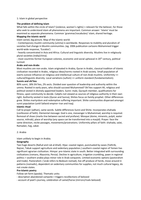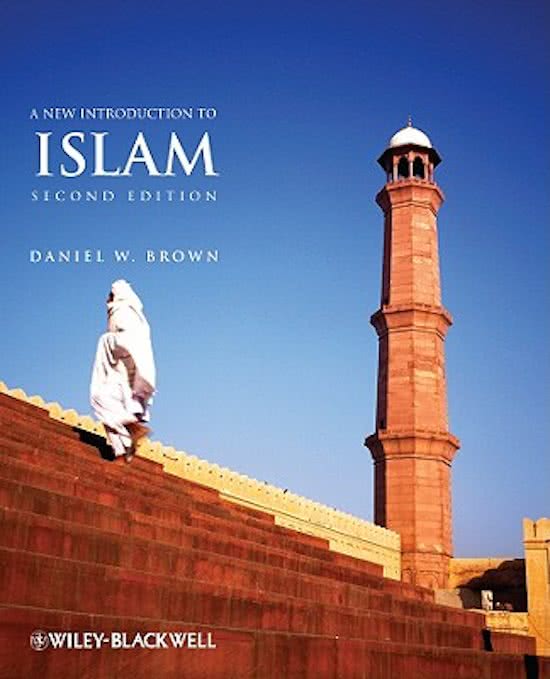1: Islam in global perspective
The problem of defining Islam
What falls within the circle of Islam? (violence, women’s rights) > relevant for the believer, for those
who seek to understand islam all phenomena are important. Common answer: ‘islams’ must be
examined as separate phenomena. Common ‘grammar/vocabulary’ islam, shared heritage.
Mapping the Islamic world
Islam varied, big picture. Map of the Islamic world:
- Contemporary muslim community (umma) is worldwide. Responses to mobility and pluralism of
societies fuel change in Muslim communities. (eg. 2006 publication cartoons Mohammed trigger
world-wide response, ‘Eurabia’)
- heavily concentrated in Asia and Africa. Cultural and linguistic diversity. Muslims live in religiously
plural societies (india/china).
- most countries former European colonies, economic and social upheaval in 20th century, political
turmoil.
Arabs and non-Arabs
Most muslims are non-arabs. Islam originated in Arabia, Quran in Arabic, classical tradition of Islamic
civilization recorded in Arabic, religious ideas/norms rooted in Arab society. Small population of
exerts outsize influence on religious and intellectual culture of non-Arab muslims. Uniformity <>
cultural/linguistic diversity. Local variations (sufism) <> uniform standard (fundamentalism).
Sunnis and shi’ites
80% sunni, 18% Shi’ites, 2% sects. Divided over question of leadership and authority within the
umma. Rooted in early years, who should succeed Muhammed? Shi’ites support Ali, religious and
political vested in divinely appointed leaders. Sunni: male, Quraysh member, qualifications for
fitness, upon community to decide. Caliphs not viewed as sources of religious authority in their own
right. Authority vested in texts (Quran and Sunna), Shiites focus on family prophet. Other differences
grew. Shiites martyrdom and redemptive suffering important. Shiite communities dispersed amongst
sunni population (until Safavid empire> Iran and Iraq).
Islamic ritual
Call to prayer (adhan), same words. Subtle differences Sunni and Shiite. Incorporates shahada
(confession of faith). Elemental message: God is one, messenger is Muhammad, worship is required.
Removal of shoes (marks line between sacred and profane). Mosque (dome, minarets, pulpit, water
source, mihrab), place of worship (any space can be transformed into a masjid). Prayer: face the
same direction, recite passages, movements/prostrations. Uniformity pillars of faith: shahada, salat,
Ramadan, hajj, zakat.
2: Arabia
Islam unlikely to begin in Arabia.
Geography
Two huge deserts (Nafud and rub al-khali). Hijaz: coastal region, punctuated by oases (Yathrib,
Najran, Tabuk support agriculture and sedentary population.) southern coastal region of Yemen has
significant agrarian civilization. Himyar: pre-Islamic state in south. Better integrated with surrounding
civilizations (romans, Abyssinia, Persia). Decline in agriculture, irrigation crumbling, pawn in regional
politics > southern arabia plays minor role in Arab conquests. Limited economic options (pastoralism
and trade). Pastoralism: (‘arab refers to Bedouin nomad), live off produce of herds, move around in
patterns (nomadic), dependent on sedentary communities for supplies, not much cultural legacy, do
not create states.
Pre-Islamic poetry
Follow set form (qasida). Thematic units:
- description abandoned campsite > triggers recollections of beloved
- account of poet’s journey, celebration of camel/horse (mirrors/rivals beloved)





